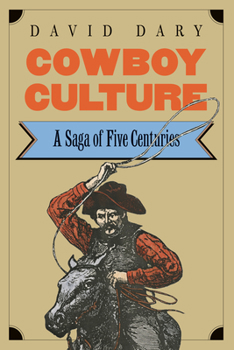Cowboy Culture: A Saga of Five Centuries
Select Format
Select Condition 
Book Overview
A nationwide bestseller--with more than 65,000 copies in print since publication by Alfred A. Knopf in 1981, this fascinating chronicle of cowboy life and legend is now available in a trade paperback edition. It's the 500-year saga of the "real cowboy"--from fifteenth-century Mexico to the twentieth-century American West.
Format:Paperback
Language:English
ISBN:0700603905
ISBN13:9780700603909
Release Date:March 1989
Publisher:University Press of Kansas
Length:384 Pages
Weight:0.80 lbs.
Dimensions:1.0" x 6.0" x 9.0"
Customer Reviews
3 ratings
Very Informative
Published by Thriftbooks.com User , 18 years ago
I read this book for a term paper and found it very informative and interesting!
Entertaining ... and informative
Published by Thriftbooks.com User , 19 years ago
I enjoyed it. The title sounds like a college textbook, but the style is very conversational and there are stories on every page. The author clearly relishes his subject. The writing is crisp and the humor is understated. He puts the cattle business in a very helpful historical perspective. Although it's not a page turner, I always looked forward to picking it up. I also expect to get more out of it the next time I read it.
Thoroughly researched, vastly informative . . .
Published by Thriftbooks.com User , 19 years ago
Currently there is no review here for this fine book, and it deserves one. For starters, the title for this well-researched history of 400 years of cattle raising in North America is not exactly right. It should be called "Cattle Culture," because cattle and not cowboys are at the center of the story the author tells. And his story traces their introduction to the New World by Columbus in 1494 through to the end of the open ranges in the American West in the late 1800s. Horses, also introduced by the Spanish, are no less a part of that story, along with the cattlemen who owned, bought, sold and sometimes stole cattle, and the horsemen (vaqueros, buckaroos, and cowboys) who worked the cattle. Readers learn a great deal about cattle as a business, how the price of livestock fluctuated with demand and depended always on getting cattle to market, often many hundreds of difficult miles away. In some periods, the value of cattle was not in the beef on the hoof but in the hides and tallow. The California vaqueros, we learn, were not just herders but also expert slaughterers of cattle. Not surprisingly, a great swath of Texas history is interwoven with the rising and falling fortunes of cattlemen, and the author puts together a detailed picture of the industry as it emerged there in the mid-19th century, foundered during the Civil War, and then flourished as the railheads worked west into Kansas. But the cattle drives from Texas to cow-towns like Abilene were only some of the many that the century witnessed, as herds were driven in various directions, sometimes by west-bound settlers on the Oregon Trail, or often to meet the sudden demand for beef wherever there were gold strikes. The author provides accounts of many of these, illustrated with maps. There are many black and white period photographs in the book, which challenge the back-lot Hollywood imagery that readers are likely to have of the West. There are also informative illustrations, like that of the early western bridle called a jáquima by the Spanish-speaking vaqueros, later anglicized to "hackamore" by their American counterparts. The reader learns of many words flowing from Spanish into English, including "ranch," from the Spanish "rancho." The meanings of Spanish words like "hacienda" (a place where work is done) are also clarified. There are also illustrations of how to throw ropes in different ways to catch cattle and horses, how to dally a rope around a saddle horn, and the design of various kinds of barbed wire. One chapter, "Bunkhouse Culture," is devoted to describing the fraternity of young men, mostly from the South, who came to be the Texas "cow-boys" that eventually emerged as the mythic figures on horseback that excited popular imagination. The author describes the unspoken "code" that bound them together and notes their quick passing from history as long-range drovers when barbed wire brought an end to the open range starting in the 1870s. About the same time, ranching as a




